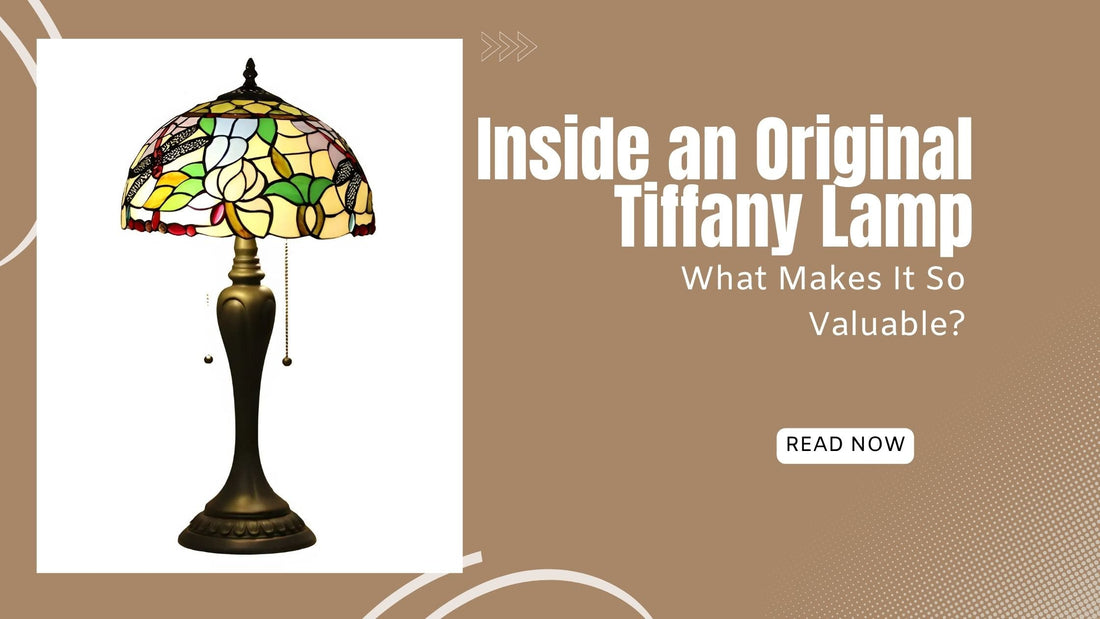
Inside an Original Tiffany Lamp: What Makes It So Valuable?
Share
Introduction
Walk into any antique fair or fine art auction, and chances are, the mention of an original Tiffany lamp will turn heads. These iconic stained-glass masterpieces are more than just decorative lights — they’re coveted collectibles, museum-worthy artifacts, and tangible pieces of American design history. But what truly sets an original Tiffany lamp apart from today’s reproductions? Is it the materials? The method? The history?
In this blog, we take a closer look at what goes into the construction of an authentic Tiffany lamp, explore a standout design in detail, compare originals to modern replicas, and offer tips for collectors searching for the real deal.
The Anatomy of an Original Tiffany Lamp

The beauty of an original Tiffany lamp is in the details — and those details are the result of expert craftsmanship, premium materials, and a meticulous creative process pioneered in the late 19th century.
1. Bronze Base: Form Meets Function
Unlike many modern reproductions that use resin or brass, genuine Tiffany lamps feature solid bronze bases. They’re:
- Heavy and durable, built to last generations
- Often decorated with nature-inspired reliefs like tree trunks, lily pads, or stylized vines
- Finished with a natural patina, not a shiny polish, to enhance their antique character
Each base was carefully cast using the lost-wax method, a sculptural technique usually reserved for fine art.
2. Handmade Stained Glass Shade: A Mosaic Masterpiece
The stained-glass shade is what most people recognize instantly — a vibrant array of floral, geometric, or abstract patterns, pieced together like a puzzle. The techniques include:
- Favrile glass: Invented by Louis Comfort Tiffany himself, this type of glass had color mixed into the molten material. Unlike painted glass, it offers rich depth and natural variation.
- Copper foil method: Each piece of glass was cut by hand, wrapped in copper foil, and soldered together. This allowed for tighter, more intricate designs than traditional lead caming.
- 3D shade molds: Glass pieces were placed over dome-shaped molds, ensuring that the final product maintained a smooth, curved form.
Depending on the design, some shades contained hundreds to over 2,000 individual glass pieces, each selected for its texture, opacity, and color.
Spotlight on a Signature Original Design: The Wisteria Lamp
One of the most admired original Tiffany lamps is the Wisteria table lamp, designed around 1901 by Clara Driscoll, one of Tiffany Studios’ lead female designers.
Key Features:
- A shade made from over 2,000 pieces of blue, lavender, and green glass
- A cascading floral pattern that mimics hanging wisteria blooms
- An irregular lower edge, giving it an organic, draping silhouette
- A bronze base resembling a gnarled tree trunk
This table Tiffany lamp is a prime example of Tiffany’s philosophy: blurring the line between art and function. Original Wisteria lamps can fetch anywhere from $500,000 to $1.5 million at auctions, depending on condition and provenance.

How Modern Replicas Compare to Originals
While many Tiffany-style lamps are beautiful in their own right, they often differ significantly from authentic originals in quality, materials, and construction.
| Feature | Original Tiffany Lamp | Modern Replica |
|---|---|---|
| Material (Base) | Solid bronze | Resin, brass, or zinc |
| Glass Type | Favrile (hand-blown, richly colored) | Stained or painted glass (mass-produced) |
| Technique | Copper foil, hand-cut glass | Often machine-cut, assembled in batches |
| Weight | Heavy due to bronze | Lighter, sometimes hollow bases |
| Artistic Detail | Irregular edges, complex shading | More symmetrical, less nuanced color blends |
| Value | High collectible worth | Affordable decorative use |
That said, high-end replicas — especially handmade copper foil versions — can still be beautiful and functional lighting choices for everyday homes. Just don’t expect them to match the value of an original Tiffany lamp.
Collectors’ Tips: How to Authenticate an Original Tiffany Lamp
Because original Tiffany lamps are so valuable, forgeries and misattributions are common. Here’s how collectors identify genuine pieces:
1. Look for Maker's Mark
Authentic bases are typically stamped with:
- "Tiffany Studios New York"
- A model number
- Occasionally the designer’s initials
This mark is usually found near the base or inside the shade’s support ring. It's worth noting that some Tiffany desk lamps may carry subtler markings depending on their size or function.
2. Examine the Glass
- Favrile glass is richly colored and often has a slight iridescent sheen.
- Look for natural imperfections — like air bubbles or subtle swirls — which are signs of handmade glass.
- Tap it gently — real glass feels cold and gives a clear, heavy ring.
3. Check the Patina
Original bronze bases develop a greenish-brown patina over time. A shiny or painted finish is often a sign of a modern reproduction.
4. Verify Provenance
Top auction houses provide full provenance — the lamp’s ownership history, photos, and expert authentication. If buying privately, request detailed documentation and a third-party appraisal.
5. Consult an Expert
Tiffany scholars, auctioneers, and organizations like the Tiffany Lamp Association or museums can help verify authenticity.
Why Original Tiffany Lamps Are a Top Investment
Aside from their aesthetic appeal, original Tiffany lamps are one of the most stable and appreciating collectibles in the antique market.
Reasons to Invest:
- Finite supply: Tiffany Studios closed in 1933. No more originals will ever be produced.
- Museum-grade craftsmanship: Each piece is a one-of-a-kind work of art.
- Historical significance: Tiffany lamps represent a golden era of American design.
- Auction performance: Prices have steadily risen, with many lamps selling for six or seven figures.
Collectors often describe owning an original Tiffany lamp as “owning a glowing piece of history.”
Conclusion: A Legacy That Still Glows
An original Tiffany lamp isn’t just a lamp — it’s a legacy of craftsmanship, artistry, and American design history. From its glowing stained glass shade to its sturdy bronze base, every detail reflects the vision of Louis Comfort Tiffany and the artisans who brought his ideas to life.
Whether admired in a museum, passed down through generations, or carefully displayed in your home, a Tiffany lamp continues to shine — not just with light, but with timeless beauty.
If you’re lucky enough to own one, cherish it. If you’re on the hunt, learn all you can — because behind every original Tiffany lamp is a story worth telling.
FAQ: Original Tiffany Lamp
1: How can I tell if my Tiffany lamp is real?
Look for:
- A stamped maker’s mark on the base
- Handmade glass with color variation
- A heavy, solid bronze base
- Expert appraisal or documentation
If you're still unsure, contact a reputable appraiser or antique dealer.
2: Why are original Tiffany lamps so expensive?
Their value comes from:
- Handcrafted quality
- Rarity
- Historical and artistic significance
- Limited supply — no new originals exist
3: Are there affordable ways to enjoy the Tiffany style?
Yes! Many artisans and brands create Tiffany-style lamps using similar techniques. While not originals, they’re affordable, beautiful, and often handmade.
4: Where can I buy an original Tiffany lamp?
Try:
- Major auction houses (Sotheby’s, Christie’s)
- Reputable antique dealers
- Specialty art galleries
- Museum deaccessions or estate sales
Always request provenance and appraisals.
5: Can I insure my Tiffany lamp?
Absolutely. Given their value, insurance is highly recommended. Work with insurers who specialize in fine art and antiques, and get a professional appraisal first.
Frequently Linked Pages
1. Tiffany Desk Lamps - Tiffany Desk Lamps: A Timeless Blend of Elegance and Functionality
2. Table Tiffany Lamp - How to Style a Room with a Table Tiffany Lamp?
